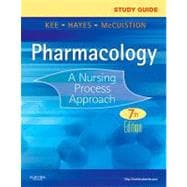
Note: Supplemental materials are not guaranteed with Rental or Used book purchases.
Purchase Benefits
| A Nurse's Perspective of Pharmacology | |
| Drug Action: Pharmaceutic, Pharmacokinetic, and Pharmacodynamic Phases | |
| Nursing Process and Client Teaching | |
| Medication Safety NEW! | |
| Medication Administration | |
| Drug Calculations | |
| Medications and Calculations | |
| Systems of Measurement with Conversion | |
| Methods for Calculation | |
| Calculations of Oral Dosages | |
| Calculations of Injectable Dosages | |
| Calculations of Intravenous Fluids | |
| Pediatric Drug Calculations | |
| Contemporary Issues in Pharmacology | |
| The Drug Approval Process | |
| Cultural and Pharmacogenetic Considerations | |
| Drug Interaction and Over-the-Counter Drugs | |
| Drugs of Abuse | |
| Herbal Therapy with Nursing Implications | |
| Pediatric Pharmacology | |
| Geriatric Pharmacology | |
| Medication Administration in Community Settings | |
| The Role of the Nurse in Drug Research | |
| Nutrition and Electrolytes | |
| Vitamin and Mineral Replacement | |
| Fluid and Electrolyte Replacement | |
| Nutritional Support | |
| Autonomic Nervous System Agents | |
| Adrenergic Agonists and Adrenergic Blockers | |
| Cholinergic Agonists and Anticholinergics | |
| Neurologic and Neuromuscular Agents | |
| Central Nervous System Stimulants | |
| Central Nervous System Depressants | |
| Anticonvulsants | |
| Drugs for Neurological Disorders: Parkinsonism and Alzheimer's Disease | |
| Drugs for Neuromuscular Disorders: Myasthenia Gravis, Multiple Sclerosis, and Muscle Spasms | |
| Pain and Inflammation Management Agents | |
| Antiinflammatory Drugs | |
| Nonopioid and Opioid Analgesics | |
| Psychiatric Agents | |
| Antipsychotics and Anxiolytics | |
| Antidepressants and Mood Stabilizers | |
| Antibacterial Agents | |
| Penicillins and Cephalosporins | |
| Macrolides, Tetracyclines, Aminoglycosides, and Fluoroquinolones | |
| Sulfonamides | |
| Antiinfective Agents | |
| Antituberculars, Antifungals, Peptides, and Metronidazole | |
| Antivirals, Antimalarials, and Anthelmintics | |
| Drugs for Urinary Tract Disorders | |
| Immunologic Agents | |
| HIV- and AIDS-Related Drugs | |
| Vaccines | |
| Antineoplastic Agents | |
| Anticancer Drugs | |
| Targeted Therapies to Treat Cancer | |
| Biologic Response Modifiers | |
| Respiratory Agents | |
| Drugs for Upper Respiratory Disorders | |
| Drugs for Lower Respiratory Disorders | |
| Cardiovascular Agents | |
| Cardiac Glycosides, Antianginals, and Antidysrhythmics | |
| Diuretics | |
| Antihypertensives | |
| Anticoagulants, Antiplatelets, and Thrombolytics | |
| Antihyperlipdemics and Peripheral Vasodilators | |
| Gastrointestinal Agents | |
| Drugs for Gastrointestinal Tract Disorders | |
| Antiulcer Drugs | |
| Eye, Ear, and Skin Agents | |
| Drugs for Eye and Ear Disorders | |
| Drugs for Dermatologic Disorders | |
| Endocrine Agents | |
| Endocrine Drugs: Pituitary, Thyroid, Parathyroid, and Adrenal Disorders | |
| Antidiabetics | |
| Reproductive and Gender-Related Agents | |
| Female Reproductive Cycle I: Pregnancy and Preterm Labor Drugs | |
| Female Reproductive Cycle II: Labor, Delivery, and Preterm Neonatal Drugs | |
| Postpartum and Newborn Drugs | |
| Drugs for Women's Reproductive Health and Menopause | |
| Drugs for Men's Health and Reproductive Disorders | |
| Drugs for Disorders in Women's Health, Infertility, and Sexually Transmitted Infections | |
| Emergency Agents | |
| Adult and Pediatric Emergency Drugs | |
| Answer Key | |
| Basic Math Review | |
| Prototype Drug Chart | |
| Table of Contents provided by Publisher. All Rights Reserved. |
The New copy of this book will include any supplemental materials advertised. Please check the title of the book to determine if it should include any access cards, study guides, lab manuals, CDs, etc.
The Used, Rental and eBook copies of this book are not guaranteed to include any supplemental materials. Typically, only the book itself is included. This is true even if the title states it includes any access cards, study guides, lab manuals, CDs, etc.